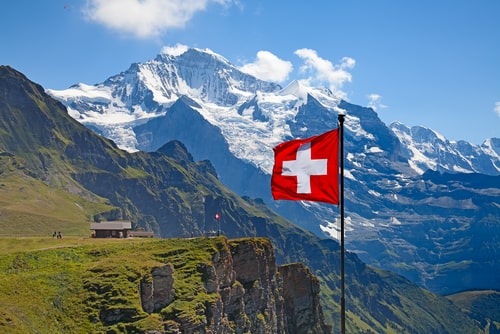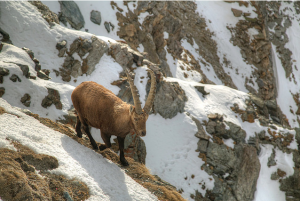Last updated on March 16th, 2022
About Swiss government
79. The Federal Council is the highest executive authority in the country. It has seven members elected by the Federal Assembly.
80. The Federal Assembly elects both the president and the vice-president. They serve a one-year term.
81. The Swiss constitution was adopted in 1848. Prior to 1848, Switzerland was a loose alliance of independent cantons.
82. A lot of ice from glaciers in Switzerland has melted in the past 40 years and this could be a reason for concern for the villages below. Between 1985 and 2009, Swiss glaciers receded by more than 390 square kilometers.
83. The ibex, a species of mountain goat, became nearly extinct in the early 1800s because of excessive hunting. However, the species was reintroduced and now more than 1500 ibex live in the Swiss Alps.
84. The average age in Switzerland is on the rise because people are living longer and are having fewer children.
About major languages used in Switzerland
85. German is spoken by 63.5% of the country’s population. 19 out of the 26 cantons in the country are (Swiss) German-speaking.
86. French by numbers is the second most popular language in the country spoken by 22.5% of its population.
87. Italian is the third most popular language in the country. It is the language of choice for 8.1% of the country’s population.
88. The rest of the population speaks other languages including native languages of the people from various nationalities.
Facts about religion, democracy, watchmaking
89. Religious groups: The majority of the people living in Switzerland are Christians and Muslims. However, a large chunk of the country’s population (21.4%) has no religious affiliation.
90. People’s power: Swiss people have a lot of power at their disposal. They are directly able to decide the fate of their country by participating in the polls held every quarter. In short, they have the direct ability to influence the government. The country has a direct democracy.
91. Diversity: Variety is the spice of life in Switzerland. It is a small country yet it has cultural as well as geographical diversity. They have four languages and cultural differences between the people living in the mountains, mountain valley, big cities, and on the central plateau.
92. Today, 95% of the watches made in Switzerland are exported to other countries.
93. Mechanical timekeeping started back in the 14th century and Switzerland wasn’t involved in it until the second half of the 16th century.
94. The skill of watchmaking originated in the country as an aftereffect on the ban of wearing of jewelry (rejection for display of wealth.) Soon, watchmaking was born and the export of watches to other colonies started.
Switzerland facts for kids
95. Switzerland has 26 cantons or states, which constitute the Confederation (Names of Cantons: Aargau, Appenzell Ausserrhoden, Appenzell Innerrhoden, Basel-Landschaft, Basel-Stadt, Berne/Bern, Fribourg/Freiburg, Geneve, Glarus, Graubuenden/Grigioni/Grischun, Jura, Luzern, Neuchatel, Nidwalden, Obwalden, Sankt Gallen, Schaffhausen, Schwyz, Solothurn, Thurgau, Ticino, Uri, Valais/Wallis, Vaud, Zug, Zuerich.)
96. Switzerland became a UN member in 2002.
97. Switzerland has four official languages.
98. Switzerland is a landlocked country in central Europe.
99. Highest: Dufourspitze of Monte Rosa at 4,634 m is the highest point in Switzerland.
100. Lowest: Lake Maggiore at less than 195 m (640 ft) is the lowest point in Switzerland.
101. There are more than 1500 lakes in Switzerland. Lake Geneva is the largest freshwater lake in Switzerland.

102. Switzerland has more than 1000 glaciers. The Aletsch Glacier is the largest glacier in Switzerland with an area of 117 km square.
103. Switzerland is famous for chocolates (Lindt & Sprüngli, Toblerone), watches, insurance and banking, civil engineering, and spectacular scenery.
104. Sports: Football and ice hockey are the most popular sports in Switzerland.

105. The national flag of Switzerland was adopted in 1848.
106. Switzerland had one song which served as its national anthem for a century. However, the countrymen did not like the song for its warlike words and also because its melody was similar to that of the British national anthem.
107. ‘Swiss Psalm’ became the official national anthem of Switzerland in 1981.
108. Switzerland the country we know today became a united nation because many regions joined the Confederation in return for their guaranteed independence.
109. Switzerland places significant importance on preserving and maintaining its architectural heritage.
110. Switzerland’s economy also relies heavily on tourism.
111. Almost 10% of the Swiss nationals are living abroad.
112. In 1971, Swiss women were granted the right to vote at the federal level.
113. Switzerland is also home to the highest permanently inhabited village in Europe (Juf, canton of Graubünden, 2,126m/7,000ft).
114. The longest glacier in Europe (the Aletsch, canton of Valais, approx. 23 km/14 miles) can also be found in Switzerland.
115. The country has laid strict regulations for construction of new buildings. This is the reason why so many traditional-style buildings can still be seen in the country.
116. Due to the lack of natural resources and raw material in the country, the economy of the country is highly dependent on the transformation of imported raw materials into high-value finished products that are mainly exported.
Facts about the famous Alp cheese
117. Made from: Swiss people make cheese from the milk of the cows, goats or sheep that graze on the Alpine pastures. And this variety of cheese (Alp cheese) is only produced in the summer.
118. Long life: Alp cheese can be preserved for a longer duration than the regular cheese, which is why the cheese could be used in the winter season as well.
119. The difference: Alp cheese is different from the mountain cheese (which can be made year-round in the valleys in the mountainous region.)
120. Beneficial for: Alp cheese is rich in omega-3 fatty acids, which is good for human cardiovascular health.
Switzerland culture facts
121. The Swiss are reserved and they do not get along quickly with the newcomers. However, as the time progresses, one gets to know the Swiss and their culture better and there is always a great potential for lifelong friendship.
122. A handshake (with firm eye contact) is a formal way of greeting people. Handshakes are also expected when leaving.
123. The Swiss like to use family names rather than the first name when greeting someone.
124. First names are usually used with close friends and family.
125. Neighbors are greeted by name and a polite ‘bonjour’ or ‘bonsoir’ depending on the time of the day.
126. A small gift such as a chocolate or flowers should be brought for the host when invited at their house for meals.

127. People are expected to arrive on time or maybe 5 minutes early for social gatherings and business appointments.
128. The Swiss cultural values include honesty, cleanliness, hard work, tolerance, punctuality, responsibility, and sobriety.
129. Swiss are also proud of their neutrality and efforts to promote world peace.
130. Swiss people show great respect for elderly people and they are really affectionate towards the kids as well.
131. Cleaning fingernails or chewing gum in public is considered rude in Switzerland.
132. It is also considered impolite to keep your hands in the pocket while talking to someone as is putting your feet on a desk or table during a conversation with someone.
133. Banking and financial industry in Switzerland is dominated by men, however, more women are becoming engaged in the industry in the recent years.
134. Sundays are a public holiday and are considered as a family day.

135. Rosti is one of Switzerland’s popular dishes. It mainly contains potatoes and was originally a breakfast dish.
136. Switzerland has mandatory military service. However, Switzerland also has a law in place which allows one to pay the ‘military service exemption tax’ in case they are not willing or are not able to perform the service. Learn more…
137. Rivella is the Swiss famous and favorite drink that is made from milk serum, water, sugar, and some secret herbs. The drink was first prepared by Dr Robert Barth in 1952. In Switzerland, it is as popular as Coke or Pepsi.

138. Globi, (often referred to as Switzerland’s Mickey Mouse.) a Swiss cartoon character, is one of the most popular characters in Switzerland. He was created by the Swiss cartoonist Robert Lips, as an advertising character for the Swiss department store Globus in 1932.
139. Circus Knie is the largest circus of Switzerland, based in Rapperswil. It was founded in 1803.
Some famous people who were born in Switzerland:
- Ursula Andress (Actress, first “Bond girl”),
- Daniel Bernoulli (Mathematician, Founder of Bernoulli’s equation),
- Roger Federer and Martina Hingis (World champion tennis player),
- Claude Nicollier (First and only Swiss astronaut),
- Peter Sauber (Founder, former head, and owner of the formula one (F1) racing team Sauber Petronas). See more…
Switzerland – country at a glance
| Country name | Switzerland |
|---|---|
| Etymology | name derives from the canton of Schwyz, one of the founding cantons of the Swiss Confederacy that formed in the late 13th century |
| Independence | 1 August 1291 (founding of the Swiss Confederation) |
| Capital City | Bern (46.9480° N, 7.4474° E) |
| Largest City | Zurich (47.3769° N, 8.5417° E) |
| Area | total: 41,277 sq km land: 39,997 sq km water: 1,280 sq km (slightly less than twice the size of New Jersey) |
| Location | Central Europe, east of France, north of Italy |
| Population | 8,971,885 (2025 est.) |
| Official Language | German, French, Italian, Romansh |
| Climate | temperate, but varies with altitude; cold, cloudy, rainy/snowy winters; cool to warm, cloudy, humid summers with occasional showers |
| Demonym | English: Swiss, German: Schweizer(in), French: Suisse(sse), Italian: svizzero/svizzera, or elvetico/elvetica, Romansh: Svizzer/Svizra |
| Borders | Germany, Austria, Liechtenstein, Italy, France |
| Land boundaries | total: 1,770 km |
| Currency | Swiss franc (CHF) |
| Religion | Roman Catholic, Swiss Reformed Church, Other Christian |
| Suffrage | 18 years of age; universal |
| National anthem | the Swiss anthem has four names: "Schweizerpsalm" [German] "Cantique Suisse" [French] "Salmo svizzero," [Italian] "Psalm svizzer" [Romansch] (Swiss Psalm) |
| Government type | federal republic (formally a confederation) |
| Terrain | mostly mountains (Alps in south, Jura in northwest) with a central plateau of rolling hills, plains, and large lakes |
| Mean elvation | 1,350 m |
| Lowest point | Lake Maggiore 195 m |
| Highest point | Dufourspitze 4,634 m |
| Natural resources | hydropower potential, timber, salt |
| National symbol | Swiss cross (white cross on red field, arms equal length) |
| National colors | red, white |
| Agricultural land | 38.7% |
| Life expectancy at brith | 83.9 years (2024 est.) |
| Birth rate | 10.1 births/1,000 population (2024 est.) |
| Death rate | 8.5 deaths/1,000 population (2024 est.) |
| Sex ratio | 0.99 male(s)/female (2024 est.) |
| Industries | machinery, chemicals, watches, textiles, precision instruments, tourism, banking, insurance, pharmaceuticals |
| Exports | $675.059 billion (2024 est.) gold, vaccines, packaged medicine, nitrogen compounds, base metal watches (2022) |
| Imports | $582.554 billion (2024 est.) gold, packaged medicine, vaccines, cars, garments (2022) |
| GDP - per capita (PPP) | $82,000 (2024 est.) |
| Internet country code | .ch |
| Time Zone | CET (UTC+1) |
| Calling Code | +41 |
| Drives on the | Right |
| Table last updated | August 08, 2025 |


